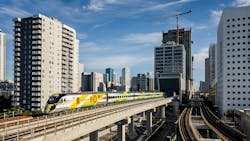Unlocking high-speed rail: Strategies for U.S. expansion
The vision of high-speed rail in the U.S. is no longer just a vision—it is steadily becoming a reality. As momentum builds, key projects are demonstrating how strategic investment, private sector engagement and innovative project delivery can accelerate progress.
Brightline West is set to become the U.S.’s first privately owned high-speed rail line, connecting Las Vegas to Rancho Cucamonga, Calif., via a 218-mile corridor. Meanwhile, California High-Speed Rail Authority is advancing its 171-mile initial operating segment, laying the groundwork for an eventual 500-mile system linking San Francisco and Los Angeles.
Beyond Brightline West and California high-speed rail, nearly 100 projects are in various stages of planning and development, with federal, state and local funding advancing both high-speed and intercity passenger rail systems. The high-speed rail projects in various stages of development include corridors in Texas from Dallas to Houston and Fort Worth to Houston; Cascadia Corridor in the Pacific Northwest; High Desert Corridor in California; and a corridor connecting Charlotte, N.C., to Atlanta.
As these projects progress, they provide valuable insights into accelerating high-speed rail development with greater efficiency. While each aim to deliver a fast, safe and modern travel alternative—capable of sustained speeds of at least 186 mph—they all employ distinct strategies to navigate funding, streamline project delivery and integrate new technologies.
The rail industry can build on these lessons to fast-track future projects, leveraging private investment, alternative delivery models and emerging technologies to create a high-speed rail network that meets America’s unique needs. A successful nationwide rollout will require strategic investment, public-private collaboration and policy support.
Strategies for advancing high-speed rail
To realize the promise of high-speed rail in the U.S. with greater efficiency, four key strategies are essential.
1. Unlocking private investment
A collaborative framework is essential for delivering high-speed rail projects, bringing together public sector leadership and private sector innovation to efficiently advance transportation infrastructure. Successful partnerships align public planning and regulatory expertise with private sector investment and project execution capabilities.
Government agencies play a critical role in early-stage planning for high-speed rail by identifying and securing corridors, advancing environmental approvals and engaging communities. These efforts help create market-ready opportunities that attract private investment, reducing reliance on public funding while ensuring projects align with broader transportation goals.
For example, Brightline West capitalized on a corridor that had been under study for 20 years. With a preapproved alignment and environmental permits in place, Brightline was able to move forward efficiently. The project’s delivery model leverages private activity bonds and precleared alignments to minimize delays, demonstrating how early public sector involvement can facilitate successful private sector investment. This project also attracted public funding through Federal Railroad Administration (FRA) grants.
A combination of early public sector planning with private capital, expertise and innovation can help accelerate project timelines, reduce reliance on public funding and improve overall project efficiency. This cooperative approach demonstrates how strategic public-private collaboration can advance high-speed rail development while aligning with broader transportation goals in the U.S.
Brightline Florida Case Study: A Model for Private Rail Delivery
Brightline Florida is currently the only privately owned and operated intercity passenger railroad in the U.S., offering sustainable and safe travel between Miami and Orlando, Fla. It stands as a pioneering example of how private sector leadership, strategic project delivery and infrastructure reuse can accelerate rail development.
By utilizing the existing Florida East Coast Railway (FEC) corridor, Brightline Florida minimized land acquisition needs, streamlined environmental permitting and reduced overall construction time. By upgrading this corridor and strategically constructing new segments, HNTB helped Brightline deliver a premium passenger rail experience in a fraction of the time it would take to develop a new corridor from scratch.
- Phase 1 (Miami–West Palm Beach, completed in 2018): Focused on upgrading existing rail infrastructure within the FEC corridor, utilizing a design-build approach to modernize tracks and stations.
- Phase 2 (West Palm Beach–Orlando, completed in 2023): Required new track construction along a greenfield corridor between Cocoa and Orlando, integrating advanced rail technologies and grade-separated crossings for high-speed operations.
With Brightline Florida now demonstrating that privately funded intercity rail can succeed, it serves as a model for future rail projects.
2. Leveraging alternative delivery models
High-speed rail development benefits from flexible project delivery models tailored to specific project needs. Given the complexity of high-speed rail, different project elements—track construction, station development, rolling stock procurement and signals and systems—often require tailored delivery methods.
Design-build contracts bundle design and construction under a single contract. This approach establishes clear owner performance requirements while allowing the design-builder to identify and implement efficiencies in both design and construction after contract award. By enabling concurrent design and construction, design-build delivery fosters innovation and helps mitigate project delays.
Variations of this model include design-build-operate-maintain, design-build-finance-operate-maintain and other models that may extend private sector involvement to different phases of the project, such as operations, maintenance and even financing.
For California high-speed rail, the team is considering a combination of traditional design-bid-build contracts with more collaborative delivery methods, such as progressive-design-build and construction manager/general contractor. Brightline West has elected to use the design-build delivery method based on its desire to optimize design and construction efficiencies and improve coordination through a single contract that spans different project phases.
This model also enables real-time engineering optimizations, allowing the project to adapt quickly to changing conditions and site-specific challenges, which is especially beneficial for sections requiring extensive earthwork.
The choice of delivery model depends on factors such as the project’s stage of engineering and design, the level of risk the project owner is willing to take, the need for flexibility and innovation, project complexity and scope, schedule constraints, private sector capacity and market conditions, and long-term operation and maintenance needs. Different delivery methods can also create opportunities to streamline the permitting process by facilitating early collaboration between project stakeholders, including third party agencies and regulatory bodies. By integrating right-of-way acquisition, environmental approvals and design development under a single contract, these models can accelerate the decision-making and ensure a more coordinated approach to project delivery.
From an agency perspective, greater specificity in contracts can reduce risk by clearly defining scope, deliverables and performance requirements, which can allow for more accurate cost estimates and better financial planning. However, giving contractors room for innovation also may yield faster and more cost-effective solutions. Striking the right balance between prescriptive requirements and performance-based flexibility is key to achieving faster, more innovative and potentially lower-cost project execution.
Brightline West case study: Accelerated timelines
Today, nearly 50 million annual trips occur between Los Angeles and Las Vegas—over 85 percent of them by car—a trip which is unpredictable, unreliable and challenged by congestion. Brightline West expects to serve more than nine million one-way passengers annually.
As a close supporting partner to Brightline West, HNTB led the planning/concept design, preliminary engineering and supported the environmental documentation for 183 miles of the high-speed rail service line in California and critical components system-wide, working closely with the California Department of Transportation (Caltrans), local agencies and the FRA.
At the initial stages of the project, HNTB proposed innovative conceptual and preliminary design solutions that assured Caltrans and the state of California that the rail line could be built efficiently and safely—and without adverse impacts to traffic—as an enclosed rail corridor within the median of Interstate 15. As a result, the overall project impact and construction schedule was reduced from the initial design concept and the established I-15 right-of-way will fast track overall delivery.
3. Driving innovation through emerging technologies
A key technology for high-speed rail is overhead electrification, which powers trains efficiently. However, emerging technologies such as hydrogen and battery-electric propulsion are beginning to complement traditional electrification. Brightline West’s use of battery-electric propulsion on inclines showcases how hybrid approaches can enhance system efficiency.
Other technological advancements include:
- Advanced signaling and Positive Train Control (PTC) to enhance safety and optimize train speeds.
- Predictive maintenance using artificial intelligence and Internet of Things sensors, reducing downtime and improving reliability.
- Real-time passenger information systems and digital ticketing, streamlining the rider experience.
The gradual integration of these technologies allows for incremental system improvements, ensuring long-term scalability while adapting to market demand.
4. Optimizing trainset procurement for efficiency and scale
Procuring trainsets for high-speed rail requires a strategic approach to balance cost efficiency, interoperability and long-term sustainability. Standardizing specifications, coordinating bulk orders across projects and fostering domestic manufacturing can help drive down costs while ensuring high-quality, reliable equipment.
Fragmented procurement remains a challenge, with individual projects pursuing custom trainset orders that can create supply chain backlogs and inefficiencies. A more coordinated approach, such as joint procurement agreements between multiple rail corridors, can create economies of scale, reduce per-unit costs and accelerate deployment timelines.
For example, Brightline West and California high-speed rail have collaborated to ensure interoperability of the two systems, as there is a potential connection between the two corridors in the future. By aligning technical standards early in the process, these projects are positioning themselves for seamless integration that could benefit the broader U.S. high-speed rail network.
Additionally, aligning trainset procurement with federal Buy America requirements supports domestic manufacturing and supply chain development, strengthening the industry for future high-speed rail expansion. Investment in standardized, interoperable train technology can also enhance flexibility, allowing trainsets to be deployed across multiple corridors as the network grows.
With limited manufacturers producing high-speed trainsets that meet U.S. performance and procurement requirements, procurement strategies must proactively address key industry concerns. This includes structuring commercial terms that account for price escalation due to global market shifts, ensuring favorable payment terms and incorporating performance surety provisions that provide confidence to manufacturers.
As more suppliers establish U.S.-based affiliates and production facilities, rail agencies have an opportunity to align procurement strategies with both high-speed rail and regional transit markets. Leveraging existing supply lines can further streamline procurement, reduce lead times and create a more resilient domestic production ecosystem for future rail expansion.
A roadmap for the future
As the U.S. advances toward a modern high-speed rail network, the lessons learned from Brightline, California high-speed rail and other emerging projects underscore the importance of meticulous early planning, private sector engagement and strategic project execution.
By embracing public-private partnerships, alternative and more collaborative delivery models and cutting-edge technology, the U.S. can accelerate project delivery, optimize costs and create a high-speed rail system tailored to its unique infrastructure needs.
High-speed rail in the U.S. is closer than ever to becoming a transformative force in American transportation. Now, the challenge is to build on this momentum, expand connectivity and ensure that high-speed rail is an efficient and scalable solution for the future.
About the Author

Peter Gertler
senior vice president, HNTB
Peter Gertler is a senior vice president at HNTB, bringing over three decades of experience in transportation and rail projects. He is recognized for his expertise in high-speed and intercity passenger rail.
